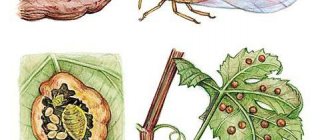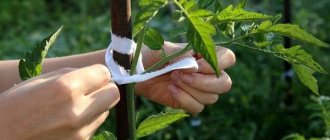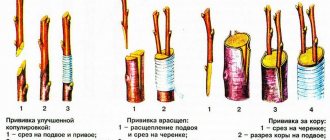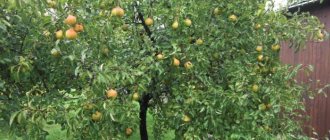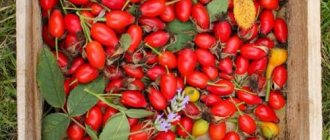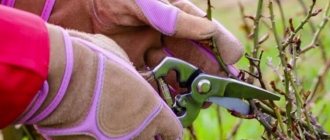Rose grafting: theory
Grafting roses onto rose hips is the main method of rose propagation. Spring is considered the best time of year when this procedure can be carried out most successfully. When planning to graft a plant, gardeners prepare in the fall.
The main key technical concept in the grafting section is budding. This term refers to a method of grafting a rose, when a specially grown rootstock bush is taken - a rose bud is grafted onto it. Usually the rootstock is rosehip, but there are other ways.
To successfully propagate rose varieties, vegetative methods are used.
When trying to obtain flowers from seeds, the result is mediocre: the resulting flowers are deprived of their original data, which is associated with a high level of splitting of these data during seed propagation.
For high-quality grafting, excellent compatibility of the rootstock and scion is required. Without this, the kidney will not take root. Incompatibility sometimes appears later, when already mature plants begin to break at the budding site. If the fusion of the rootstock with the scion is as good as possible, then this will ensure both the growth and flowering of the new plant.
Why do roses turn wild?
Amateur flower growers often wonder what is the reason that a rose turns into a rose hip as it grows. This may be due to the gardener’s lack of experience or poor quality planting material.
In the photo there is a wild rose
Some seedlings leave rosehip buds in places below the grafting and, thus, when the root system is already formed, these buds throw out shoots. New shoots drown out previously grafted shoots, taking away nutrition. The rose also runs wild due to poor choice of rootstock.
There are rosehip varieties called “early ripening”: they have aggressive, fast growth and are poorly suited for grafting. The new growth choke out the grafted crop, preventing it from growing.
The rose also turns wild due to mistakes made during planting. When the grafting site is not deepened into the ground, the scion quickly weakens and is drowned out by rose hips. When the plant is not hilled up or wrapped up with the arrival of the cold season, this also becomes the reason for the degeneration of a cultivated rose into a rose hip.
Why graft roses?
The goal of any gardener is to breed flowers and increase the collection of varieties. Roses in home floriculture are propagated vegetatively. It is often practiced to root cuttings from bouquet roses. A root plant is obtained by cuttings.
The problem of frost resistance is solved by rose hips, which gardeners successfully use as a rootstock.
Grafted roses have a number of advantages over rooted roses. Arguments in favor of rosehip vaccination:
- the grafted plant has greater vitality;
- begins to bloom early;
- has good immunity;
- not afraid of winter frosts.
You can use a different variety of rose as a rootstock. The point is to accelerate development, to bring the flowering period of the rose closer due to the well-developed and fast-growing root system of a different variety.
In temperate climates, it is recommended to use Rósa canína - dog rose. This shrub grows in the European part of Russia, Crimea. Rosehip rootstock is ideal for growing roses in alkaline and slightly alkaline soils. Other varieties can be used as rootstock:
- multi-flowered rose (multiflora Thnb) - suitable for southern regions with mild climates;
- Far Eastern rose (rugosa Thnb) - used for breeding vigorous and park varieties of roses;
- Chinese rose (rosa chinensis).
Terms
Key terms to understand:
- Scion.
- Rootstock.
- Cutting.
- Peephole.
- Neck.
Rootstock is a plant that is grafted into the root collar or stem.
A scion is a part of a plant (bud, cutting) that can take root and continue to develop on another plant - a rootstock, preserving varietal characteristics.
A cutting is part of an annual shoot with buds.
The eye is a bud located in the leaf axil.
The neck is a small segment at the junction of the root and the trunk.
Vaccination dates
The timing of vaccination is best done in the summer, somewhere in the last ten days of July or the first of August. It is then that sap flow increases, the bark easily moves away from the wood, and the graft takes root better.
In the spring, vaccination is also possible, it is better to do it before the buds break, this is somewhere at the end of April or the very beginning of May.
It is most difficult to vaccinate in winter, as there is a lot of hassle. First, young seedlings are planted in containers and grown in the basement, and cuttings are prepared in the fall and stored in a cool place.
What you will need in the process:
- Rosehip is a rootstock, one-year or two-year-old.
- Cuttings taken from the middle part of the cultivated stem.
- A sharp knife or grafting pruner.
- Garden varnish for lubricating cuts.
- Dressing material - electrical tape, pieces of polyethylene, special garden dressing tape.
Budding instructions
Any beginner must know how to graft a rose onto a rosehip. This procedure is divided into several stages.
The photo shows rose budding step by step
How to choose the right rootstock
- When choosing a rootstock, preference should be given to varieties with high cold resistance.
- The variety must also be resistant to fungal diseases. Rose hips fully meet these requirements. Another positive point is the small number of thorns that interfere with the grafting procedure. All these reasons force gardeners to choose rose hips as a rootstock.
- Rootstock plants must be strong and healthy. Must be at least one year old, but not more than five years old. The optimal thickness is up to 7 mm.
- About two weeks before budding, loosen the rose hips and make sure the soil is moist. The day before the grafting procedure, the rose hips are watered with slightly warmed water without lime.
- A little later, just before grafting, the soil from the bush is raked off and the root collar is exposed. It is washed well with water and rubbed with a napkin on the place where the vaccination will be done.
Preparing rose buds
When carrying out summer budding, the scion material is prepared immediately. If the grafting is done in the spring, before the buds open, then the cuttings are stored in the fall. They must be stored in a cold place, for example, a basement or refrigerator with a temperature of minus 4 - plus 1. The day before cutting the cuttings, the plant is moistened abundantly.
Preparing rose buds
Process description
It is advisable to carry out vaccination in the morning, before the moisture has dried under the influence of high air temperature. The weather should be warm, without rain.
- On the day of the procedure, full shoots, up to 5 mm thick, are taken from the rose. One larger bud is selected from the middle part of the shoot - it will be used as grafting material.
- On the wiped and prepared root neck of the rootstock, carefully cut the bark in the form of a large T. On the scion shoot, carefully bend the shield and cut it at a shallow depth, dividing the petiole along with the bud. The edges of the cut on the rosehip are slightly unfolded with a knife and a bud is inserted into the formed gap.
- The bud is pressed tightly to the rootstock, trying not to break it. The budding area is well tied with a garden tourniquet, but the eye must be open.
- After grafting, the plant needs to be covered with loose and moist soil. After a couple of weeks, you can examine how successful the vaccination was. If the leafy black has fallen off, but the bud remains green, it means that the fusion of the rootstock and scion has given a positive result.
- The length of the shield cannot be less than 3 cm: with a larger area of contact, the chance of survival increases.
- Tools must be as sharp and disinfected as possible. Gardening photodegradable tape is usually used as a strap; you can use electrical tape or polyethylene.
What can you graft a rose on?
Most often, a rose is grafted onto any rose hip. Also, any rose bushes that grow in the garden can be used as a rootstock. In this case, the color of the inflorescences does not play any role. Almost any wild rose bush will be suitable as a rootstock.
However, there is no clear requirement that grafting be carried out exclusively on roses or rose hips.
In our country, the flower is most often grafted onto the rootstock of the Kanina rose. But here it is necessary to take into account its vigorous growth. If miniature or polyanthus species are grafted onto it, an increase in their growth will be observed, which is provoked by the powerful and branched underground root system of the rootstock. As a result, annual pruning will contribute to the rapid depletion of the roots, which will ultimately lead to the death of the entire bush.
Therefore, for miniature or polyanthus species, it is better to use fragrant (Rust) rose bushes as a rootstock. This bush is characterized by more moderate growth. Rose Fragrant is distinguished by a significant branching of the root system, good frost resistance and easy propagation.
In addition to these varieties, varieties such as the Wrinkled or Prickly rose can be used as a rootstock. But these varieties have a large number of thorns, which greatly complicates the grafting procedure. Therefore, many gardeners choose the Cinnamon (May) or Dog rose. These varieties have few thorns and other advantageous characteristics (such as winter hardiness).
As a result, before starting the grafting procedure, it is necessary to select the correct varieties for the scion and rootstock. At the same time, experts advise giving preference to those varieties that not only bloom beautifully, but also have other useful characteristics. These characteristics include:
- cold resistance;
- high immunity;
- simple care, etc.;
These parameters will allow you to minimize the care of the bushes during the season, and will also protect the plants from freezing during the cold season.
Grafting method: copulation
Copulation is a grafting method with two or three eyes. This method is considered the simplest and is suitable even for beginners. It is better to plant in early spring, before the sap begins to flow. To carry out grafting using the copulation method, the main thing is the same diameter of the rootstock and scion.
On both sides, an oblique cut is made, maintaining the same angle of inclination. You need to be able to make cuts in one movement; for this, the tool must be well sharpened. After making the cut, the rootstock and scion must be combined and tightened with a tight bandage.
Rules for copying
- Cuttings for copulation should be taken care of in November.
- Make cuts with a perfectly clean, disinfected and sharpened instrument. You can take a garden knife or a special grafting pruner.
- Do not dirty the cut area, otherwise there is a risk of infecting the plant. Therefore, it should not be touched with crayfish. If the scion suddenly falls to the ground, it is rinsed in water, and the cut itself is renewed.
- The junction is wrapped very tightly. This will retain moisture and ensure the graft is secure.
- It is better to carry out copulation in the evening or on a cloudy day. It is unacceptable to do this in hot or rainy weather.
- Well grafted cuttings grow actively. As soon as they grow three centimeters, the bandage can be removed so as not to overtighten the plant. The grafting site is covered with garden varnish.
Plant grafting options
Let's consider spring grafting as the most popular among gardeners. All work begins in the middle of the first spring month.
There are two ways:
- copulation (merging of rootstock and scion). The method is called splitting;
- budding - grafting with a bud. The method is called propagation by eye.
The first method is used only on those shoots that have already become woody. You may ask why young shoots are not used? Their internal tissue is too soft and does not promote fusion. As a percentage, this is expressed as approximately 50x50.
Into the cleft (copulation)
On the rosehip you need to make a longitudinal cut, in the root part of the trunk. The bark at the incision site is pushed back. The prepared scion cutting is inserted into it. It is prepared using the following method: below the bud, it is cut obliquely, a two-centimeter cut. Above the cut, you need to make a cut across the trunk with a small indentation (1-2 mm). The latter is made in the form of a protrusion.
The connection point must be tied with any suitable material. To avoid confusion between the bottom and the top, the upper part of the scion is cut off obliquely.
After the procedure, the bushes are placed in some container. If you have prepared a lot of material, then you need to put moss (sawdust) in the container. Don't forget to keep the litter moist. Sometimes mold appears in it due to moisture; a little crushed charcoal will help prevent this.
We place the box with the prepared cuttings in a cool place where the temperature does not rise above 15 degrees. It is necessary to create conditions under which the cuttings will be surrounded by high humidity and a constant temperature. This is the only way to quickly form a growth at the grafting site. In agricultural technology it is called “callus”, which means callus. This is what the resulting growth resembles.
The temperature must be constant and not fall below plus 10, otherwise the formation of a build-up is difficult. And if the temperature is above 15 degrees, then the buds begin to actively swell, which is also not good at that time.
About three weeks after the event, the temperature in the room should be increased. The existing buds stop blooming, but fusion will continue. After all, the process itself is quite lengthy.
Complete union of the rootstock and scion occurs no earlier than one and a half to two months after the operation. We remove the bandages from the cuttings and plant the bushes in the garden. It is necessary to cover the plantings with film - this is necessary to protect the buds from drying out.
The bushes are covered with earth. Gathering it around the trunk in the form of a mound, which needs to be lightly compacted. As new shoots appear, the soil is gradually raked away from the tree. This is done either in the evening, after sunset, or in cloudy weather. This will avoid sunburn, because the new shoots are still weak and need a couple of days to get stronger.
Popular: Planting loosestrife for an alpine garden
Bush formation
As soon as you consider that new shoots have appeared in sufficient quantities, you can begin to form a bush. To do this, the top of the bush is cut off. This stops its further development and initiates the appearance of additional lateral shoots.
It is the latter that need to be protected, since they are the ones intended for flowering. If the central shoot continues to grow after pruning, then it needs to be pinched again. This is done in the area of 5-6 leaves. If you did everything correctly, then from three to five young shoots, located symmetrically, will form around it.
T-shape or budding secrets
The procedure is a little more complicated. Here we use a special budding knife; it is with this that the eye is cut from the rose. It can be cut with or without wood. This is done like this: count about 8 mm from the kidney. up and cut down. We leave a piece of up to 12 mm under the bud. length. The result will be a cut of wood with a total length of up to 30-40 mm.
The cut should not be too thick. For proper budding, experience is required, so gardeners suggest first practicing on other less valuable plants, such as rose hips. And not to spoil expensive rose bushes. Ideally, you should have a pink bud on the bark (wood) 3-4 cm long on your hands, with no visible damage.
A cross-section of the bark is made in the shape of the letter “T” on the rosehip, the edges of the cut are bent to the sides and the cut bud is inserted into it. This procedure is more typical for summer vaccination. Also, the junction is tied with available materials.
Many gardeners ask: how do you know if a bud is ready for grafting? The selection is carried out from a bush that has already faded from its middle part. And readiness is determined simply by the thorns. You need to try to break them off - if they break off easily and without bark, then that’s it, the bud can be cut off.
Budding - eye grafting
Budding is a common grafting method. The scion is a single bud or eye, as amateur gardeners call it. The eye is taken from a cultivated shoot and grafted onto the trunk of wildflowers.
In the spring, the peephole formed last summer is used. It can be taken from shoots harvested in the fall or in February. This bud will give rise to a new shoot in the same year.
In the summer, the vaccination is done with the bud of the current season, cutting it off just before the procedure. It will slowly take root, overwinter and give rise to new shoots only in the next season. Therefore, gardeners call such a peephole “sleeping”.
Grafting standard roses
Standard roses are easily recognized by their beautiful, lush crown, which is supported by an elongated standard. This is an exclusively cultivated plant; it does not grow in the wild. Standard varieties are budded in the same way as regular ones.
- Before the rose grafting procedure, the rootstock is cleared of soil, washed, dried and a classic T-cut is made. Several eyes are taken from a standard rose, without the bark shield. A cut is made on the rootstock, and without removing the knife, they move the edges of the bark with it and fill it with the shield of the new bud. If it does not fit, it is reduced by taking away the side parts of the shield.
- After placing the eye into the incision, the bark is tied as tightly as possible. The classically correct option: length 19-20 cm, width – 1 cm. This will ensure the closest contact between the trunk and the shield.
- After two to four weeks we can talk about the effectiveness of the vaccination. During this time, the bud will swell and the leaf will fall off. If the attempt is unsuccessful, the bud will dry out or turn brown.
Standard rose pruning method
Photos of standard roses
Grafting roses onto a standard
Features of spring vaccination
When budding in the spring, mature buds are used that have overwintered in a cold place and are ready to germinate. This type of grafting is called budding with a germinating eye. As a rule, shoots harvested in the fall are used. Sometimes you can take material from a bush that has successfully survived the winter. The cuttings are carefully inspected for damage or disease.
Sick, dried out, blackened ones should be selected immediately.
Spring budding is worked out according to the generally accepted algorithm. After its completion, the rootstock is pruned. The height of the cut should be 1/3 of the length of the cutting.
The only convincing indicator of the success of rose grafting is the germination of the eye. Without this, you will have to try budding again in the summer.
If the vaccination is done in the spring, the strapping is left for a year. To avoid constrictions and damage to the bark, elastic materials are chosen.
Rules for choosing a rootstock
Rose hips intended for rootstock are grown in advance. He must be 2 years old at the time of vaccination. Rosehips are harvested in the fall, and the seeds are immediately sown in the ground to a depth of 5 centimeters to form a long root collar. The following spring the shoots sprout.
At the beginning of summer, they pinch the top so that a strong root system is formed.
Once a month the bushes are fed with minerals. Before frost they are mulched with humus. After 2 years, in mid-summer, the seedlings are ready for budding. At this point, the thickness of the root collar should be 4 millimeters. If the neck thickness is 8 millimeters, then such seedlings are not budded, but used for grafting with cuttings. It is done at the end of autumn.
See also
Description of rose variety Rosarium Jutersen climbing, planting and plant careRead
Two weeks before budding, the rootstock is prepared with an eye. It is watered regularly, as a result of which the cambium is saturated with moisture and the bark is well separated.
Features of summer vaccination
Summer budding of roses onto rose hips is called dormant eye grafting. This is due to the fact that the bud appeared in the new year. If the scion and rootstock have taken root, full development and growth will be possible only with the arrival of a new spring, that is, after wintering.
The leaf blade is removed from the scutellum, preserving the petiole. This petiole will signal how well the graft has taken root or died.
After one and a half to two weeks, the blackberries are checked. Upon contact, it falls off, and the eye remains green. These signs indicate the success of rose grafting. Otherwise, the vaccination will have to be done again.
The graft cannot be frozen, so before the onset of cold weather the plant is mulched and covered. Mulch should be a material that retains heat well, such as peat or sawdust. The plant also needs to be protected from rodents, which often attack during wintering.
In spring, the plant is freed from excess soil and bulk material, otherwise it may rot. The binding is removed so that there are no ties. The plant is cut at a height of one centimeter above the grafting site. This, in turn, better activates the growth and development of the new kidney. Then the rose is hilled up again, making the mound higher.
Step-by-step instruction
The procedure itself is performed in the following order:
- During summer grafting, cuttings are cut on the day when grafting is planned. If the event is scheduled for spring, then the branches from the roses are cut in advance - in November or December. After harvesting, autumn harvests are rolled into film and transferred to a cool room for storage.
- The lower part of the rosehip is freed from the earth embankment. At the selected location, make an incision in the shape of the letter “T” with a sharp knife.
- The rose cutting is separated from the main trunk, leaving the “heel” and bud.
- The place of the cut on the rose hip is enlarged, going deeper into the trunk. The lower part of the rose cutting is inserted into the place where the cut is made.
- The “mother” rosehip and the daughter rose are connected to each other with electrical tape. Only the “eye” is left.
The rosehip bush is covered with fertile soil. Water and leave to graft.
Key points for winter budding
Winter budding of roses occurs in the first two months of winter - January and February. In December, budding is not carried out due to low light activity. When choosing a rootstock, choose young rose hips, harvested in the fall. They are planted in containers with turf and placed in the basement or other cool, dry place.
The rootstock must have an even root collar at least 1 cm thick. A standard rose can be grafted onto less massive necks, but the success of the enterprise will still be 50/50.
Winter grafting of roses should be practiced a month after placing the rootstock in a warm place. A couple of weeks before vaccination, the temperature in the room is gradually increased and brought to 18 degrees. It cannot be raised above 20 degrees, as there is a risk of rot.
In a few days, the rosehip will begin to flow sap and produce fresh shoots. When cut, the bark will come off easily; this is important when grafting.
Caring for rose hips after grafting
- Over the course of a week, the grafted shrub is watered abundantly with settled water. It is necessary to remove weeds, clean the area of foreign plants, and loosen the soil.
- With high-quality grafting in the fall, the rose will produce young shoots. To ensure a safe wintering, the bush is hilled up and mulched with dry leaves and sawdust. They get rid of such shelter in the spring. Since the bush will begin to rot and rot.
- In the spring, the grafted part of the bush is cut off by one eye, about half a centimeter, and covered with garden varnish. After three weeks, the eyes will hatch. After three leaves appear, the crown is pinched. It is better to remove the buds and pinch out all young shoots. This will allow the gardener to grow a spreading, lush bush.
- In the fall, the annual bush can be planted in a permanent place.
How to graft roses from a bouquet
Roses are also grafted from a bouquet. The process looks like this:
- The bouquet is placed in water for four days.
- Cuttings with two buds are cut and the thorns are removed.
- The stem is separated at the bottom by one and a half centimeters and placed in the solution to take root.
- Prepare soil enriched with humus and plant the rose.
Grafting roses onto rose hips has long been practiced by gardeners. This is not so difficult to do if you follow the tips and recommendations given above. A competent approach, high-quality material and careful attitude will help to successfully carry out grafting and obtain new varieties.
Caring for grafted plants
After the vaccination is done, it is necessary not to unwind the film for 3-4 weeks. The bush is watered regularly
After this time has elapsed, the film is carefully removed and the grafting site is inspected. If the bud is green, it means the scion has taken root
However, it should be noted that depending on the period of budding, care may differ:
After budding in winter, the film is not removed until mid-April
After which the root system is carefully opened and the grafting site is cleared; if the material was grafted in the spring, care must be taken to thoroughly insulate the rosehip root system. If the weather conditions are warm, the film is removed after 3 weeks; For buds that were grafted at the end of summer or autumn, it is recommended to leave the film until spring, since young shoots are very weak and may not tolerate a sharp drop in temperature.
After the material has been accepted, it is important to properly replant the young bush. Transplantation to a permanent place of growth should be carried out only after young shoots have grown by 15 cm
It is important to consider that the grafting site is very weak and can quickly become damaged if handled incorrectly.
Transplanting a seedling
The transplant is carried out as follows:
Using a shovel, you must carefully dig up the bush, trying not to damage the root system. Using pruning shears, separate the root system on which the bud is grafted. Prepare the planting hole and plant the seedling. The depth of the hole should be higher than the scion level. Carefully compact the soil. It is necessary to water the young bush every other day.
After new shoots appear, a complex fertilizer can be used. It is also recommended to promptly remove weeds, which often cause pests. In the future, care for the crop is carried out as for an ordinary adult rose.
It is necessary to water a young bush every other day. After new shoots appear, a complex fertilizer can be used. It is also recommended to promptly remove weeds, which often cause pests. In the future, care for the crop is carried out as for an ordinary adult rose.
Further care of the young bush
Important. By grafting several buds from different varieties, you can grow a rose with different bud colors
This bush has an original spring appearance and will decorate any flower bed.
To grow a rose garden in the garden, you don’t have to spend money on purchasing planting material - you can graft a rose onto a rose hip. This procedure requires some knowledge and often not all grafts take root among beginners. However, after gaining a little experience, everyone will be able to regularly expand their flower garden and grow not only bush roses, but also standard ones.
